Interview with Andreas Münnig from the association Solidarische Landwirtschaft Kleve e.V. Part 2
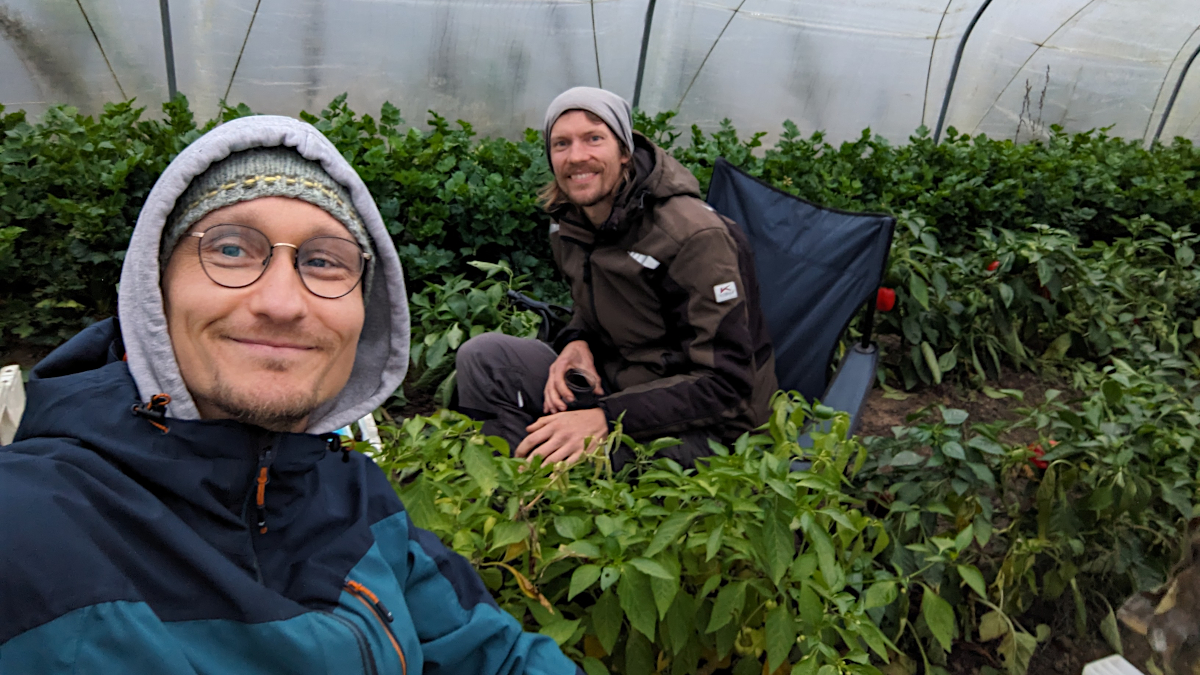
Interview in the Solawi greenhouse with Andreas from Solawi Kleve and Lars from Aspermühle
Here is the 2nd part of the interview with Andreas Münnig from the association'Solidarische Landwirtschaft Kleve e.V.'.
Lars Aspermühle: The background to becoming a member of a solidarity farming association is surely also that you want to know where your own food comes from, how it is grown and what you are eating?
Andreas Münnig: Definitely. I think every member who registers with us has this background, that
they want to know where the vegetables or food come from and how it is grown.
But no one necessarily has to integrate into this community, or take part in the members' meetings or help out. In principle, you can also go to the field or the pick-up station, pick up the vegetables and leave again, just like going to the supermarket.
However, in order to promote the sense of community a little more, it would be desirable if people were involved and took part in the activities.
Especially at the beginning, it makes sense for us to introduce a certain dynamic in order to make this project attractive and sustainable. Because it's not just about getting something up and running for a year. We want to think long-term so that we can continue to harvest good vegetables in the years to come.
Another important point is transparency. We have no secrets and people can come to the field, have a look and help out.
Everything is always open, both the finances and what we grow and how we grow it.
Lars Aspermühle: Do the members have a say in this?
Andreas Münnig: Everyone can have a say.
If someone doesn't like a particular vegetable, they can tell us.
And if several members feel the same way, we can grow less of it next season or remove it completely from the range.
Lars Aspermühle: Can members who don't like a certain type of vegetable swap it for another.
Andreas Münnig: Yes you can. We had one person today who took double the amount of celery because another member wanted another share of lettuce.
And then people just swap.
At the moment, they still have to coordinate, but we can organize that a bit better.
There is also the option of putting a box in which you can put the vegetables you don't like at all.
The other people then know that you can simply take the vegetables in this box with you and maybe put something else in there.
Lars Aspermühle: So that it's not left over at the end?
Andreas Münnig: Right. If we harvest 20 kilos of tomatoes, 20 members each get one kilo.
If someone doesn't take the tomatoes with them, we end up with one kilo of tomatoes left over.
With one kilo, that's not so tragic, but if several members do it, then there are three or four kilos left over and then I don't know what to do with them.
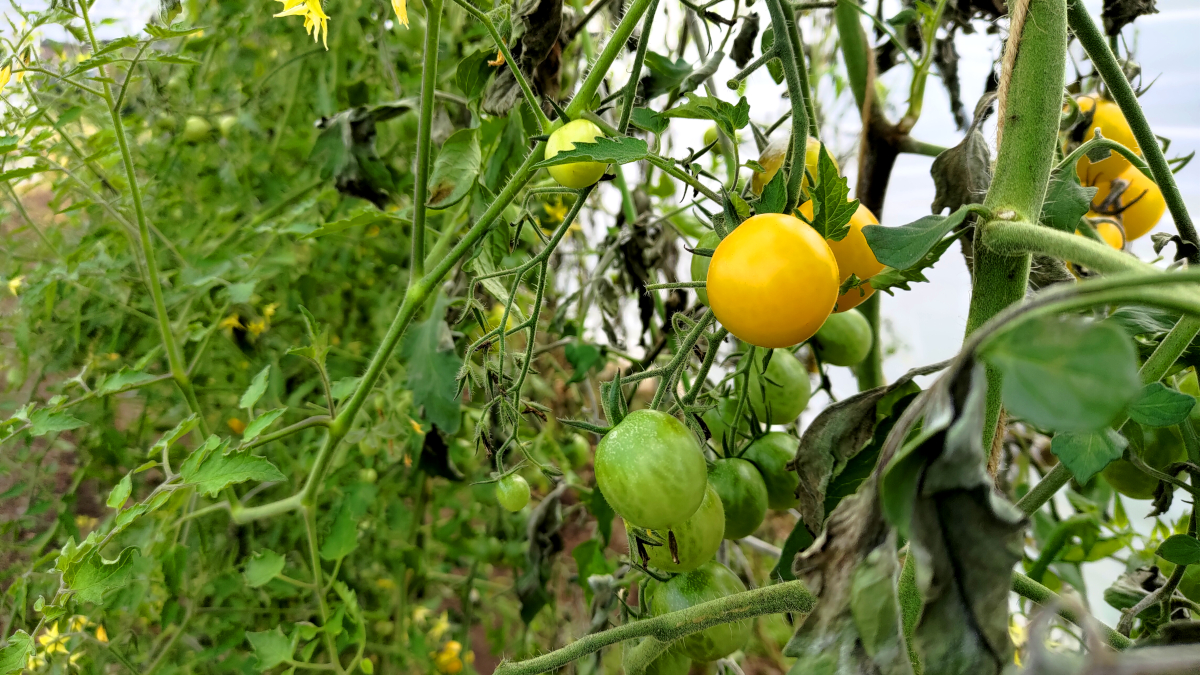
Yellow tomatoes in the Solawi greenhouse
Lars Aspermühle: What happens when you have some left over? Do you have a use for them?
Andreas Münnig: Not directly, but there's usually not that much left over. We have neighbors here that I can distribute it to.
If it's only small quantities, I sometimes ask people in the neighborhood if they want the vegetables.
Or I've also put a box on the street and then just written "to give away" on it and then people could take it.
Lars Aspermühle: What plants or vegetables are you currently growing?
Andreas Münnig: We have a very diverse selection.
There were originally 27 crops planned for this year, but we ended up not planting a few crops after all. We also get potatoes from the Berkhöfel farm.
Lars Aspermühle: I can already see a few things here: tomatoes, peppers, celery and eggplants.
Andreas Münnig: Exactly, we now have the celery, peppers, tomatoes and cucumbers here in the greenhouse and the rest outside. These are the classics, such as carrots, beans and zucchinis.
So everything you can eat raw, but also cook, lettuce and cabbages.
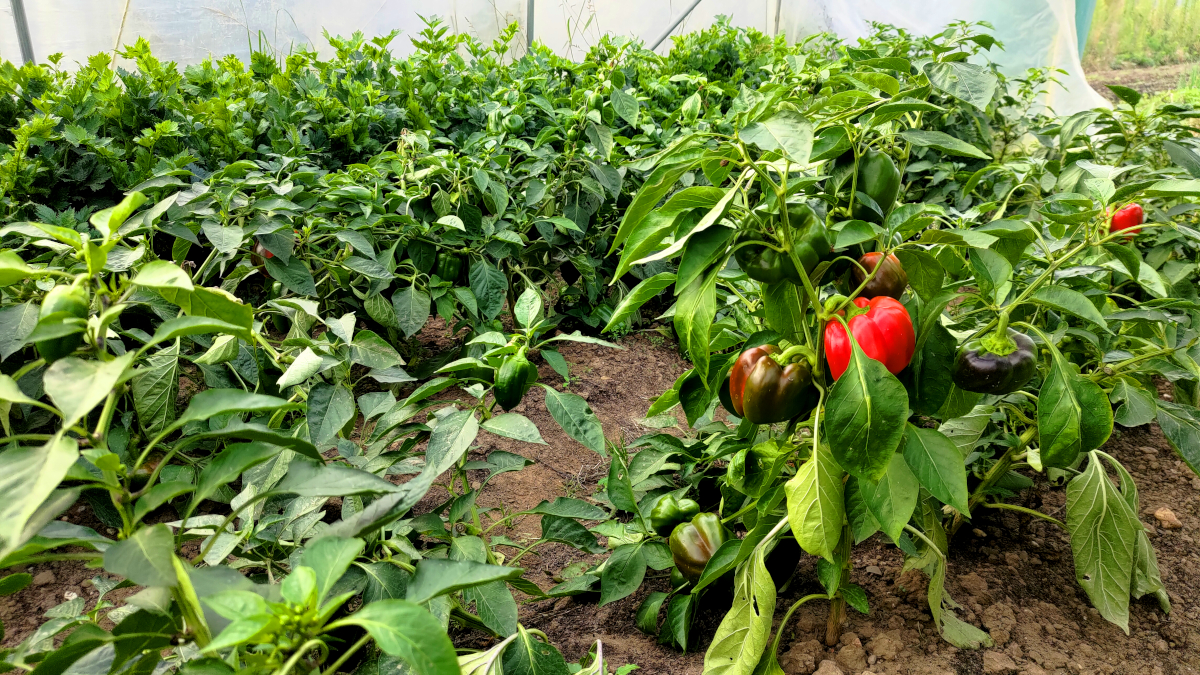
Lars Aspermühle: What are the future plans? Do you want to harvest vegetables throughout the year so that there is always something available for the members?
Andreas Münnig: Yes, this year we don't have a year-round harvest season.
We want to continue harvesting until the end of December or maybe even into January.
But then we'll stop for a while and take a break until around mid-April.
Then we'll start harvesting again.
Lars Aspermühle: What could you harvest so early in the year?
Very early carrots and also lettuce and spinach.
Lars Aspermühle: And late in the year probably a lot of cabbage, Brussels sprouts for example?
Exactly you can start with an early set of kale, for example.
Kohlrabi also goes quite early if you grow it in a foil tunnel.
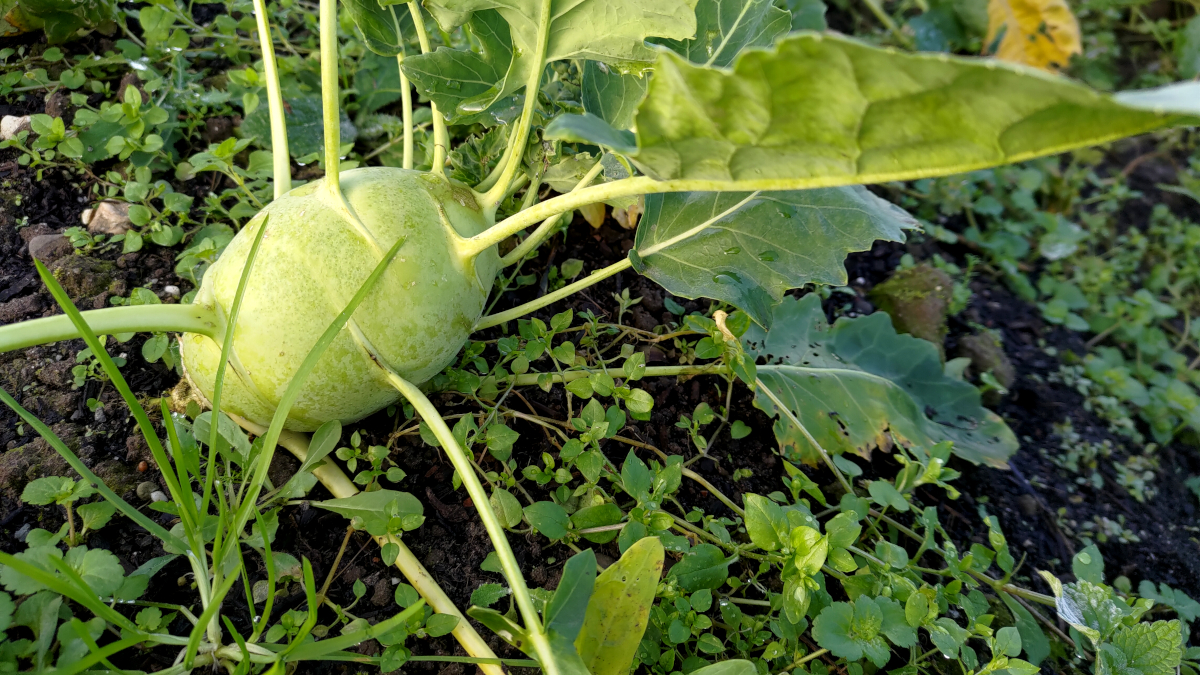
Kohlrabi in late autumn
Lars Aspermühle: What criteria do you use to choose which crops and varieties to grow?
Andreas Münnig: This year, I simply made a personal selection based on my own preference.
For the future, we have conducted a survey among the members to find out what they would or would not like. I will then adapt the selection based on this and plan accordingly.
The varieties are currently still being selected based on my personal choice.
I make sure that we always use seed-resistant seeds, because we don't want to use hybrids.
So that we can also use our own seeds in the future and because I am simply more behind seed-resistant seeds.
Aspermühle's comment on the difference between hybrid and varietal seeds:
Hybrid seed is created by crossing two plants. For this purpose, two plant lines are bred over several generations to have the most positive characteristics possible, for example a higher yield, better storability or greater resistance to diseases and pests.
In the end, these two plants are crossed with each other and the positive characteristics of both plants are obtained, which of course offers advantages in the first generation.
From the second generation onwards, however, these advantages are unfortunately lost, as the seed of the subsequent generations is unfortunately not stable, because from this point onwards the negative characteristics of the plant begin to show again. For example, growth difficulties and significant yield losses can occur.
In addition, the subsequent generations are at least partially sterile. This is due to the breeding of the plants. Since you want to cross 2 specific varieties with each other, you naturally want to prevent one variety, the so-called mother variety, from fertilizing itself. This means ensuring that this variety either produces no pollen or only sterile pollen. This can be done with the help of genetic engineering, for example. However, the so-called father plant naturally needs fertile pollen in order to fertilize the mother plant.
The advantage of varietal seeds would therefore be a stable genetic make-up, so you get the same plant in every generation. Although the yield may be slightly lower, the taste is often better. In addition, you can of course grow the seeds yourself, whereas with hybrid seeds you are dependent on the manufacturer and have to buy them again and again.
Lars Aspermühle: It's clear that individual companies can't get rich?
Andreas Münnig: Exactly. We will probably also collect seeds for a few crops next year. For example, zucchinis or various tomato varieties. This year, we haven't collected that many of our own seeds yet.
But in the long term, we definitely want to produce our own seeds. To create a cycle.
Lars Aspermühle: Do you have to be careful with some varieties because of backcrossing or cross-pollination? Zucchinis or pumpkins, for example.
There have been cases from time to time where people have propagated their own seeds and then suffered poisoning.
Aspermühle's comment:
At this point, we would like to draw your attention to our do-it-yourself guide to pumpkin carving for Halloween.
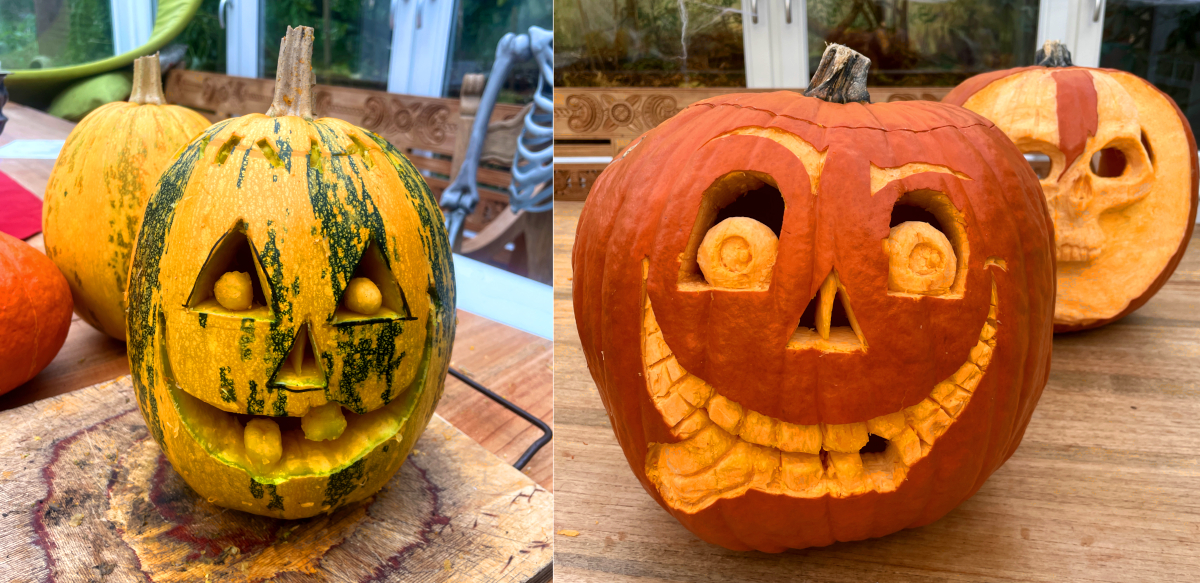
Carved pumpkins for Halloween
Andreas Münnig: There is exactly this problem with pumpkin hybrids.
If you buy a pumpkin in the store, it is usually a hybrid, for example a cross between an edible pumpkin and an ornamental pumpkin. If you then use this seed for breeding and grow a new pumpkin, the seed may end up producing a variety that is just as poisonous as an ornamental pumpkin.
Lars Aspermühle: That wouldn't be a problem with a varietal seed?
Andreas Münnig: There is no such risk with varietal seed. With this seed, you have the same variety again later.
Lars Aspermühle: Where do you get your seeds or seedlings from?
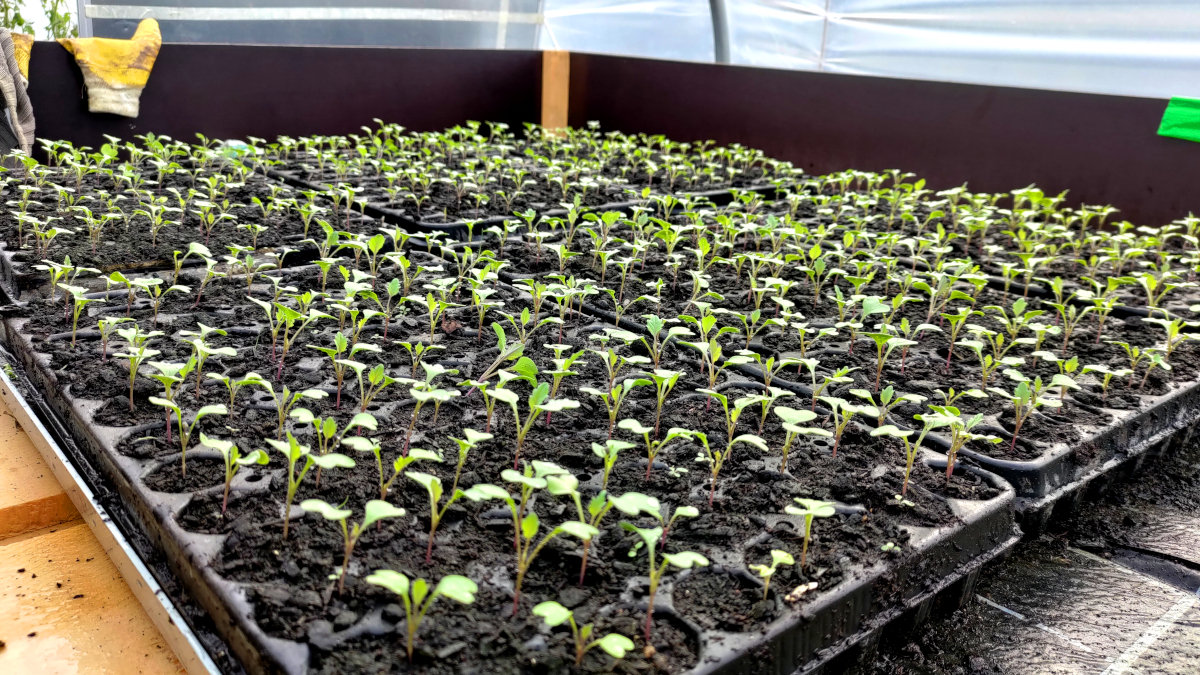
Seedlings in the greenhouse
Andreas Münnig: We bought a few additional young plants this year because we had problems growing young plants in the spring.
And we simply got them from an organic supplier of young plants.
Unfortunately, there were also a few hybrids among them.
But that was an absolute exception. It shouldn't happen again.
But the seed that we then use for our plants comes from various suppliers who produce this varietal seed.
Lars Aspermühle: What principles do you grow according to? You said earlier that you don't use machines, that it's all done by hand? Are there any machines that you would use?
Andreas Münnig: We grow here according to the principles of market gardening.
This is a method that allows little to no soil cultivation.
And we also don't use any artificial sprays or fertilizers.
Lars Aspermühle: What is the soil quality like and what measures are you taking to improve it?
Andreas Münnig: We use a lot of compost as a basic fertilizer.
Lars Aspermühle: Home-grown compost?
Andreas Münnig: We've just bought some.
We also produce our own compost, but it's not enough at the moment.
However, it would be possible to produce enough compost ourselves in the future.
Lars Aspermühle: Fertilization is probably also more difficult if you don't have livestock?
Andreas Münnig: Yes, it is more difficult to get the required amount of nutrients if you really produce purely plant-based compost.
Lars Aspermühle: Yes, because you need enough biomass. Otherwise you end up with just one cycle. And if you take away the vegetables and eat them, some of the biomass is missing.
Andreas Münnig: That's exactly the point.
So you have to bring in external fertilizer because you always lose biomass. Otherwise the whole calculation doesn't work out.
ILars Aspermühle: You're still buying in compost externally at the moment, so to speak?
Andreas Münnig: Exactly, so we get compost from the composting plants here in the area.
Lars Aspermühle: From Schönmackers?
Andreas Münnig: Exactly, we're actually quite happy with that and it's produced from regional waste.
There are different types of compost there. Ours, for example, does not contain any animal ingredients. In principle, we are currently practising vegan farming.
I don't know whether we will continue to do this in the future.
I actually think that we should also include a little animal input, such as manure.
Lars Aspermühle: So are you possibly aiming for animal husbandry in the long term, chickens or bees for example?
Andreas Münnig: That's not planned at the moment.
As far as animal husbandry is concerned, I would perhaps settle for chickens that can just run around freely.
When I leased the field in Uedem at the time, the landlord also had chickens that could run around freely and he could then always attract them and they also came. That was great.
They could have their own way, so to speak, and could have run away.
But as soon as you put up a fence, humans try to establish a power that I don't really want to support.
Because we humans really want the meat or the milk, we put up a fence and want to have control over the animal.
But we don't know whether the animal really wants to be there or perhaps somewhere else entirely. It's just there because it can't go anywhere else.
And I don't think that's actually the right way.
Or take meat, for example. If you eat game that's been shot, I think that's fine. But if you take meat from the butcher or from livestock farming, normal animal husbandry, that's not the right way for me.
Lars Aspermühle: So you're purely concerned with animal husbandry?
It would be okay for you to eat an animal from the forest that has run free? Even for yourself?
Andreas Münnig: I'm a vegetarian, but I can understand that because living creatures eat other living creatures
And that's okay. That's just the way it is in the animal kingdom.
As long as every animal can somehow run away and still somehow develop a tactic to escape, then you should give the animal the opportunity.
I think it's strange to single us out as a special species and say that we're just going to do it the way we want to.
Lars Aspermühle: But would, for example, runner ducks be an option, which then eat away the snails here?
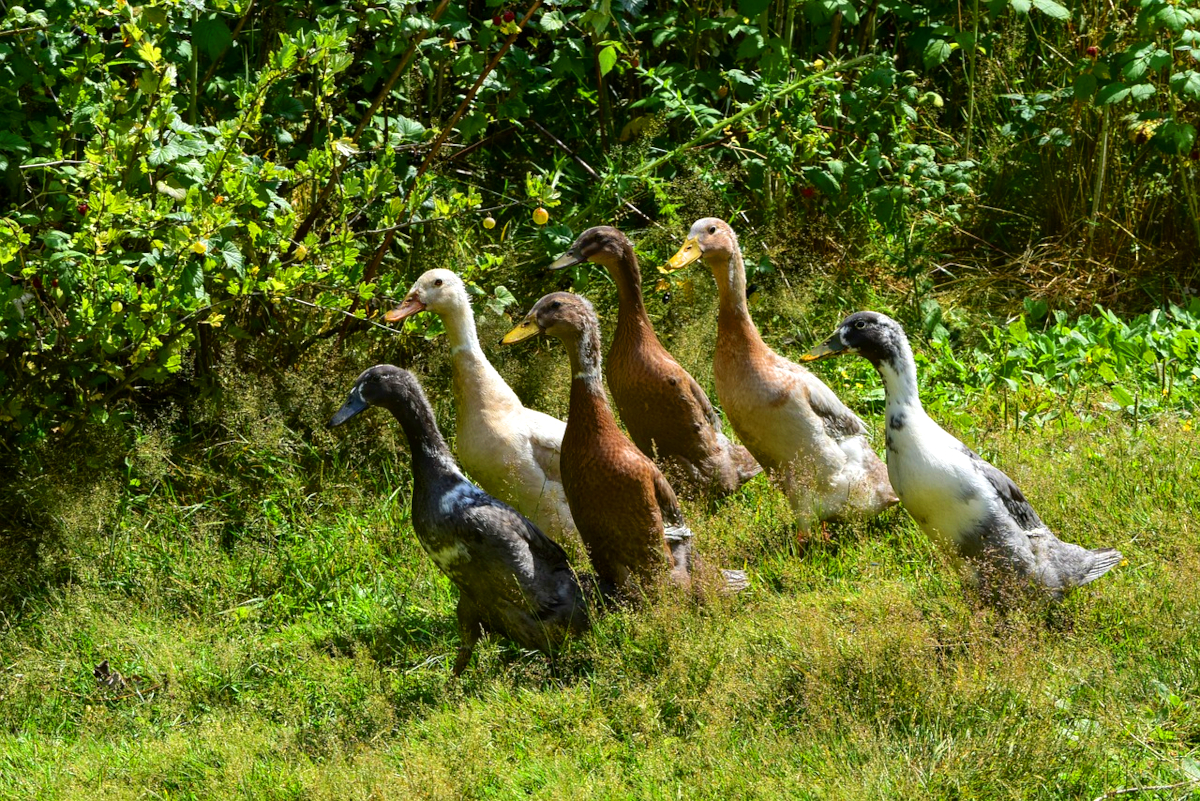
Runner ducks in the grass
Andreas Münnig: I actually had that back then in Uedem.
They also ate slugs and that definitely helped, but with such a large field, that doesn't work. It was quite big back then and the ducks also ate a few snails, but I don't think it made that much of a difference overall.
You'd have to keep a lot of runner ducks for it to be really noticeable.
Lars Aspermühle: I've seen it sometimes in Asian countries, where there really are a few hundred animals running across the fields.
In the following video you can see how runner ducks are used to combat a plague of snails.
Andreas Münnig: It may be that it works. Back then in Uedem there were only two ducks.
Lars Aspermühle: Are you doing anything to increase pollinator output? In this sense, would it be an option to place beehives here to pollinate the plants?
Andreas Münnig: Yes, I think bees are great, I've thought about it before.
But then it would definitely have to be beekeeping that is appropriate for the species.
That's a topic in itself, of course. If someone somehow needs an area where they want to do that, they're welcome to do it with us.
But for me, it would simply go beyond the scope of what I can do now.
Aspermühle comment:
At this point, we would like to draw your attention to the interview with beekeeper Marco Janßen, who keeps bees in a way that is appropriate to their nature.
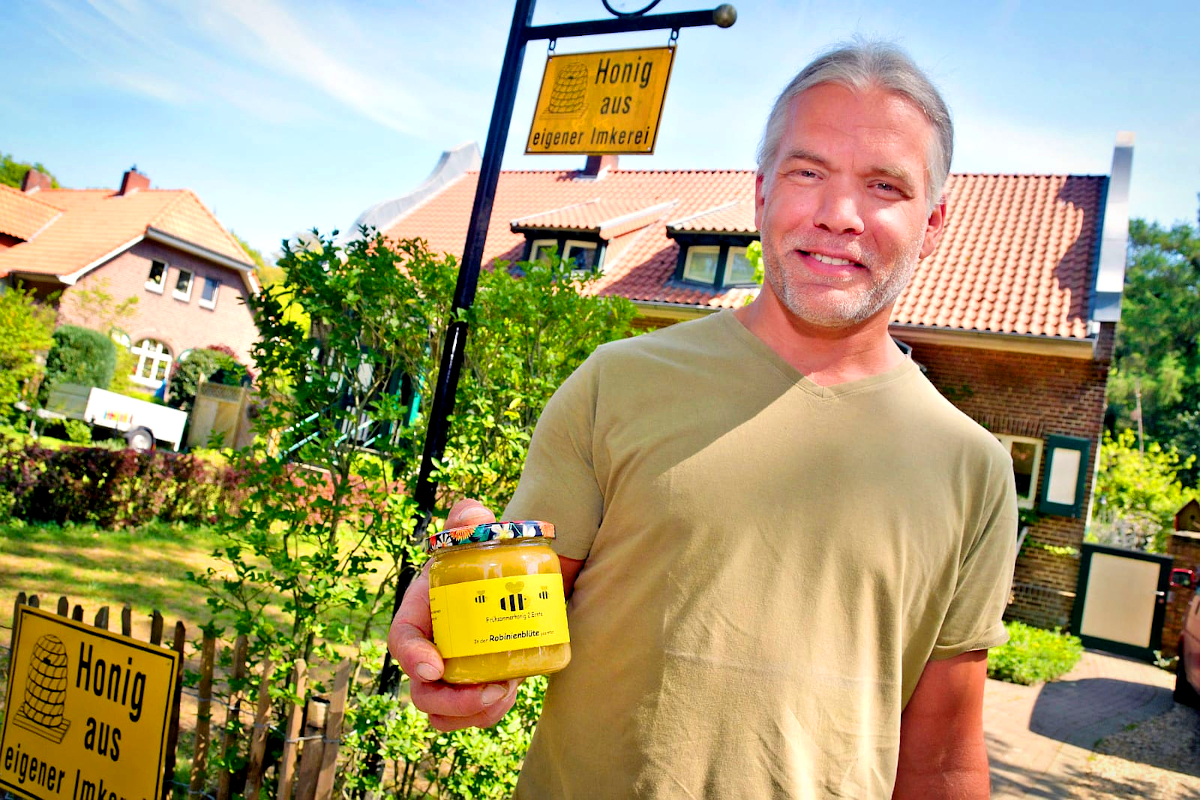
Andreas Münnig: In the greenhouse, it sometimes makes sense to put up bumblebee boxes because pollination is a bit lower.
But if we create another flower strip right next to the greenhouse here, so that the bees can get a bit close and then move through the foil tunnel, that will be enough.
Lars Aspermühle: You could also create nesting opportunities for insects.
I've created clay tubes in my garden, for example, where I've put in reeds for mason bees. But these are quite specialized Bumblebee boxes would also be a possibility.
Aspermühle's note: At this point, we refer you to our guide article 'Wild bees in the agricultural landscape' by Anna-Lea Ortmann.
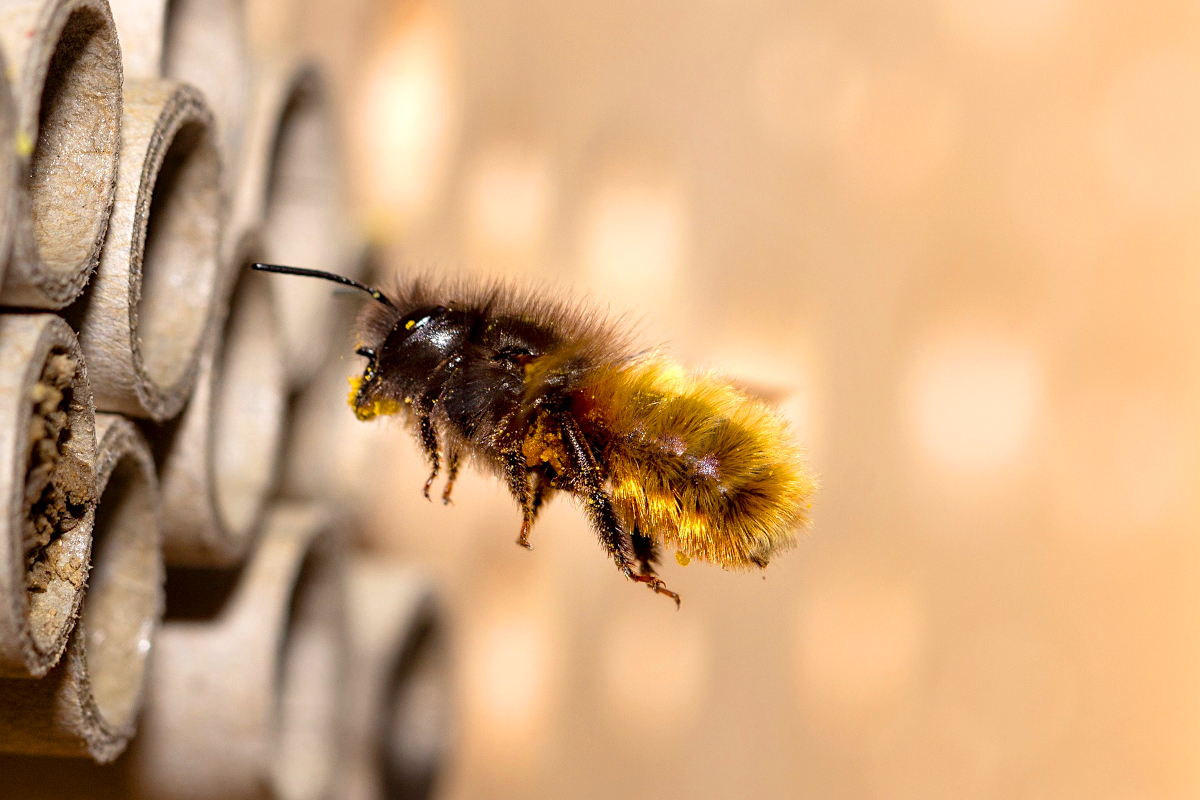
Andreas Münnig: Exactly, we want to go into more detail there too.
This year the focus was very much on building the infrastructure, creating the beds and growing the first plants.
I think next year that will definitely come our way, that we will create flowering meadows and that we will do a lot for insect diversity and biodiversity.
That this will simply become a very lively place and that all creatures can somehow feel at home here.
Lars Aspermühle: Does species protection, landscape protection play a role? What about agroforestry?
Andreas Münnig: Yes, I would also like to do agroforestry here.
But we have to see whether that is compatible with the city.
A green strip is to be created at the edge here and trees could also be planted there.
Aspermühle comment:
Agroforestry refers to a system of agricultural land use in which perennial plants such as shrubs and trees are combined with annual crops. Elements of animal husbandry are also partially integrated here. This offers a number of advantages. These include reduced soil erosion, greater protection against evaporation and a higher water storage capacity. In addition, the containment of pests and diseases and the promotion of beneficial organisms instead. You can also find more information on this in our guide article 'Wild bees in the agricultural landscape' by Anna-Lea Ortmann.
Andreas Münnig: Well, there are different agroforestry systems.
In some cases, a few trees are simply planted on the edge of arable land.
These then have different functions. On the one hand, symbioses take place.
On the other hand, the trees provide wind protection and help to stabilize the soil.
But there are different levels, some of which already go in the direction of permaculture.
So when creating a forest garden or a dynamic agroforestry system, a very high level of diversity is offered in a small space.
Annual crops, perennial crops and even trees that may live to be over 100 years old. All of this is integrated into this system.
Lars Aspermühle: That's also important for species conservation, that insects can interact between different areas.
Andreas Münnig: Yes, exactly, these are projects where you take nature as a model and cultivate it as nature-friendly as possible.
And these systems are actually, if these areas are then prepared in this way, at some point no longer so labor-intensive and very productive.
I mean, I've heard that these areas have 40 percent more yield than normal arable land.
Lars Aspermühle: Yes, I can imagine that. If you have plants that favor each other.
And then of course you also have a higher pollinator performance if you create a climate in which many insects feel comfortable.
Andreas Münnig: Right, that all plays a role. And these systems are naturally much more resilient, less susceptible to pests and much more resilient due to the diversity.
If a plant gets sick, it won't spread directly across the whole site, but will be stopped by another plant that doesn't have a problem with it and the disease won't spread further.
Exactly, that's how it is in nature.
Lars Aspermühle: Drought is probably less of a problem then too. Depending on what you plant.
Sea buckthorn plants, for example, are well known for their ability to retain water.
Aspermühle's note: You can find more information on this topic in our guide 'Native superfoods & edible wild plants'
Andreas Münnig: Yes, exactly, we're already doing that anyway through the principle of market gardening.
The fact that we don't till the soil and also leave all the root mass in the soil creates a sponge effect.
We will probably also work with biochar in the future, which also stores water very well.
And by not destroying this entire soil structure, the water storage capacity of the soil increases over the years.
This is of course particularly good in today's times, when dry years and extreme weather can occur.
Lars Aspermühle: Just like in the last few years. This year it was very wet again, but the years before that were sometimes extremely dry.
Andreas Münnig: That's definitely advantageous, for such weather extremes.
On the one hand, the forest gardens, but our current system is already very much heading in that direction too.
Lars Aspermühle: You had just mentioned permaculture. How do you irrigate? Do you irrigate additionally? And how much do you have to irrigate?
Andreas Münnig: The foil tunnels have to be watered regularly, of course. At the moment, we still do this manually or we already have a hose and water with it. There is no automatic irrigation system, for example drip irrigation, which is then switched on and off automatically.
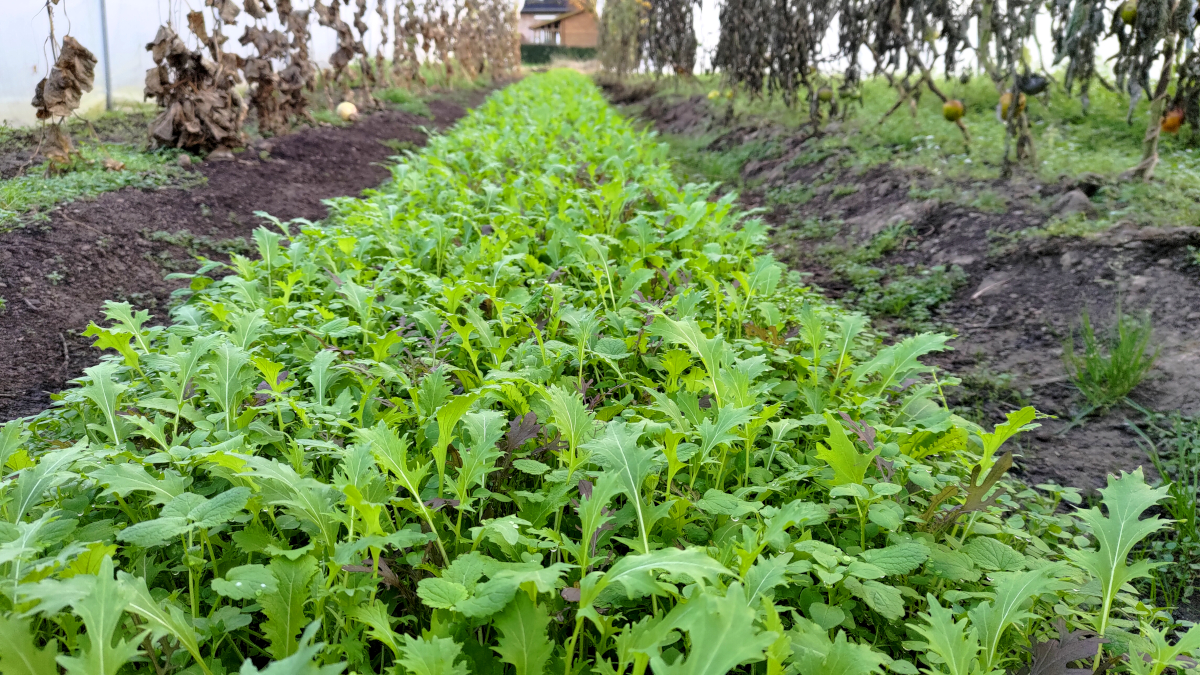
Lars Aspermühle: That would probably make sense? Because then you use less water because you can irrigate precisely.
Andreas Münnig: Yes, exactly, that would also make sense. That's also something that's included in the budget plan for next year, so that we can get a proper irrigation system for next year, because it's also very time-consuming.
It was so intensive in this first year anyway, even though we already had a very wet year. But it takes about an hour just to water the polytunnels.
Lars Aspermühle: Back to the agroforestry again. Do you have a certain degree of planning security here with the city of Kleve?
Do you have a long-term contract or is it renewed every year?
Andreas Münnig: Yes, we only had a one-year contract this year, but we've already been promised that we can stay here for the next three years.
Lars Aspermühle: Well, that's a start.
Andreas Münnig: Exactly, that's a start. That's quite a long time for municipal leases. Normally, they only sign one-year contracts with farmers.
Of course, we have a special position because of the particular type of farming we do. Because we do everything by hand, it would be a huge effort for us to go somewhere else next year.
If another farmer with a tractor simply had to go somewhere else,
he ploughs the field with his tractor and then has reached the basic state again. That's not such a huge effort.
But for us, it takes weeks or months of work to get back to this basic state.
Lars Aspermühle: What are they like at the city? Can you have a sensible conversation with them?
Andreas Münnig: This year they were a bit cautious at first and wanted to see how serious we were about it. But now things have developed quite well.
Lars Aspermühle: That's nice. Does anyone from the city of Kleve ever come by, take a look and take an interest?
Andreas Münnig: Someone from the city came here once and had a look around and everything was fine so far.